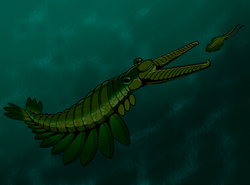Arthropods reported from the Marjum Formation Genus Species Presence Material Notes Images Anomalocaris A. nathorsti Sponge Gully. [ 10] Partial body (USNM 374593). [ 10] Species moved to the genus Peytoia . Asaphiscus A. wheeleri Bathyuriscus fimbriatus Subzone. [ 11] A ptychopariid trilobite. Baltagnostus B. eurypyx All subzones of the Bolaspidella Zone. [ 11] Multiple specimens. [ 11] A diplagnostid trilobite. Bathyuriscidella B. aff. B. amplicauda Bolaspidella contracta Subzone. [ 11] 3 pygidia . [ 11] A dolichometopid trilobite. Bathyuriscus B. elegans Bolaspidella contracta Subzone. [ 11] Numerous specimens. [ 11] A dolichometopid trilobite. B. fimbriatus Bathyuriscus fimbriatus & lower Bolaspidella contracta Subzone. [ 11] Numerous specimens. [ 11] A dolichometopid trilobite. Bolaspidella B. contracta Bolaspidella contracta & lower Lepojyge calva Subzones. [ 11] A menomoniid trilobite. B. housensis Bathyuriscus fimbriatus Subzone. [ 11] A menomoniid trilobite. B. jarrardi Localities 347, 391, and 716 (mid-Bolaspidella Zone). [ 12] Multiple specimens. [ 12] A menomoniid trilobite. Branchiocaris B. pretiosa Sponge Gully. [ 10] [ 13] 3 specimens. [ 10] A hymenocarine . Buccaspinea B. cooperi Kells Knolls locality. [ 14] An almost complete specimen (BPM 1108). [ 14] A hurdiid , originally reported as Hurdia sp. Burlingia B. halgedahlae Localities 347 and 716 (mid-Bolaspidella Zone). [ 12] Multiple specimens. [ 12] A burlingiid trilobite. Caryosyntrips C. camurus 'Red Wash' locality. [ 14] 2 isolated frontal appendages. [ 14] A panarthropod of uncertain classification. Cotalagnostus C. laevus Bolaspidella contracta Subzone. [ 11] Over 50 specimens. [ 11] A diplagnostid trilobite. C. sp.Bolaspidella contracta Subzone. [ 11] A pygidium . A diplagnostid trilobite. Dicranocaris D. guntherorum Red Wash, Modocia Flats & Sponge Gully. [ 13] 4 specimens. [ 13] An arthropod of uncertain classification. Dytikosicula D. desmatae West of Delta, House Range . [ 7] 1 specimen (SM X.50203). [ 7] A putative megacheiran . Elrathia E. alapyge Bolaspidella contracta & Lejopyge calva Subzones. [ 11] Numerous specimens. [ 11] A ptychopariid trilobite. E. marjumi Bathyuriscus fimbriatus & Bolaspidella contracta Subzones. [ 11] Numerous specimens. [ 11] A ptychopariid trilobite. Emeraldella E.? sp.Red Wash. [ 10] Part & counterpart (KUMIP 204791). [ 10] An artiopod . Hemirhodon H. amplipyge Bolaspidella contracta Subzone. [ 11] 14 incomplete specimens. [ 11] A dolichometopid trilobite. Holteria H. problematica Marjum Pass (Lejopyge calva Subzone). [ 11] A pygidium . [ 11] A corynexochid trilobite. Homagnostus H. incertus Bolaspidella contracta Subzone. [ 11] Multiple specimens. [ 11] An agnostid trilobite. Hypagnostus H. parvifrons All subzones of the Bolaspidella Assemblage Zone. [ 11] Numerous specimens. [ 11] A diplagnostid trilobite. Itagnostus I. interstrictus House Range . [ 15] A peronopsid trilobite originally reported as Peronopsis interstricta . Leanchoilia L.? cf. protogonia Sponge Gully. [ 13] Part & counterpart of a complete specimen (UU 06011.01). [ 13] A megacheiran . Lejopyge L. calva Marjum Pass (Lejopyge calva Subzone). [ 11] Numerous specimens. [ 11] A ptychagnostid trilobite. Linguagnostus L. perplexus Bolaspidella contracta Subzone. [ 11] Over 20 specimens. [ 11] A diplagnostid trilobite. Marjumia M. callas Bolaspidella contracta Subzone. [ 11] A marjumiid trilobite. M. typa Bolaspidella contracta Subzone. [ 11] A marjumiid trilobite. Modocia M. laevinucha Bathyuriscus fimbriatus & Bolaspidella contracta Subzones. [ 11] Many specimens. [ 11] A marjumiid trilobite. M. nuchaspina Bolaspidella contracta Subzone. [ 11] A marjumiid trilobite. M. typicalis 50 or more specimens. [ 11] A marjumiid trilobite. Naraoia N. compacta Sponge Gully. [ 16] 4 specimens. [ 16] A naraoiid . Neolenus N. inflatus East of Antelope Springs. [ 17] Multiple specimens & fragments. [ 17] A trilobite. N. intermedius East of Antelope Springs. [ 17] A trilobite. N. intermedius pugio East of Antelope Springs. [ 17] 4 specimens of a pygidium . [ 17] A trilobite. N. superbus East of Antelope Springs. [ 17] Multiple specimens & fragments. [ 17] A trilobite. Nettapezoura N. basilika Sponge Gully. [ 13] An arachnomorph . Olenoides O. decorus Bolaspidella contracta Subzone. [ 11] 7 specimens. [ 11] A dorypygid trilobite. O. inflatus Bolaspidella contracta Subzone. [ 11] A dorypygid trilobite. O. marjumensis Bolaspidella contracta Subzone. [ 11] A dorypygid trilobite. O. pugio Bolaspidella contracta Subzone. [ 11] Numerous specimens. [ 11] A dorypygid trilobite. O. superbus Bolaspidella contracta Subzone. [ 11] 7 specimens. [ 11] A dorypygid trilobite. Pahvantia P. hastata Precise localities unknown. [ 14] 3 specimens. [ 14] A hurdiid . Peronopsis P. interstricta House Range . [ 15] Numerous specimens. [ 11] Reassigned to the genus Itagnostus . P. segmenta House Range . [ 15] Multiple specimens. [ 11] A peronopsid trilobite. Perspicaris P.? ellipsopelta Ptychagnostus punctuosus Zone. [ 18] Valves & carapaces. [ 18] A bivalved arthropod. Peytoia P. nathorsti Sponge Gully. [ 10] Partial body (USNM 374593) & partial mouthpart (KUMIP 314095). [ 19] A hurdiid , formerly named Anomalocaris nathorsti . Ptychagnostus P. akanthodes Bolaspidella contracta Subzone. [ 11] Numerous specimens. [ 11] A ptychagnostid trilobite. P. atavus House Range . [ 15] A ptychagnostid trilobite. P. hybridus Bolaspidella contracta Subzone. [ 11] About 10 specimens. [ 11] A ptychagnostid trilobite. P. richmondensis Bathyuriscus fimbriatus Subzone. [ 11] Numerous specimens. [ 11] A ptychagnostid trilobite. P. sp.Bolaspidella contracta Subzone. [ 11] At least 5 pygidia . A ptychagnostid trilobite. Trymataspis T. depressa Bolaspidella contracta Subzone. [ 11] Over 30 specimens. [ 11] A lonchocephalid trilobite. T. lomaleie Bolaspidella contracta Subzone. [ 11] 10 cranidia. [ 11] A lonchocephalid trilobite. T. pristina Bolaspidella contracta Subzone. [ 11] Over 20 cranidia. [ 11] A lonchocephalid trilobite. Tuzoia T. guntheri Ptychagnostus punctuosus Zone. [ 18] Multiple valves & carapaces. [ 18] [ 20] A hymenocarine . Utagnostus U. trispinulus Bolaspidella contracta & Lejopyge calva Subzones. [ 11] Multiple specimens. [ 11] An agnostid trilobite. Utaspis U. marjumensis House Range & Wheeler Amphitheater. [ 11] A ptychopariid trilobite. Zacanthoides Z. sp.Wheeler Amphitheater (Bolaspidella contracta Subzone). [ 11] A cranidium. [ 11] A zacanthoidid trilobite. 











































